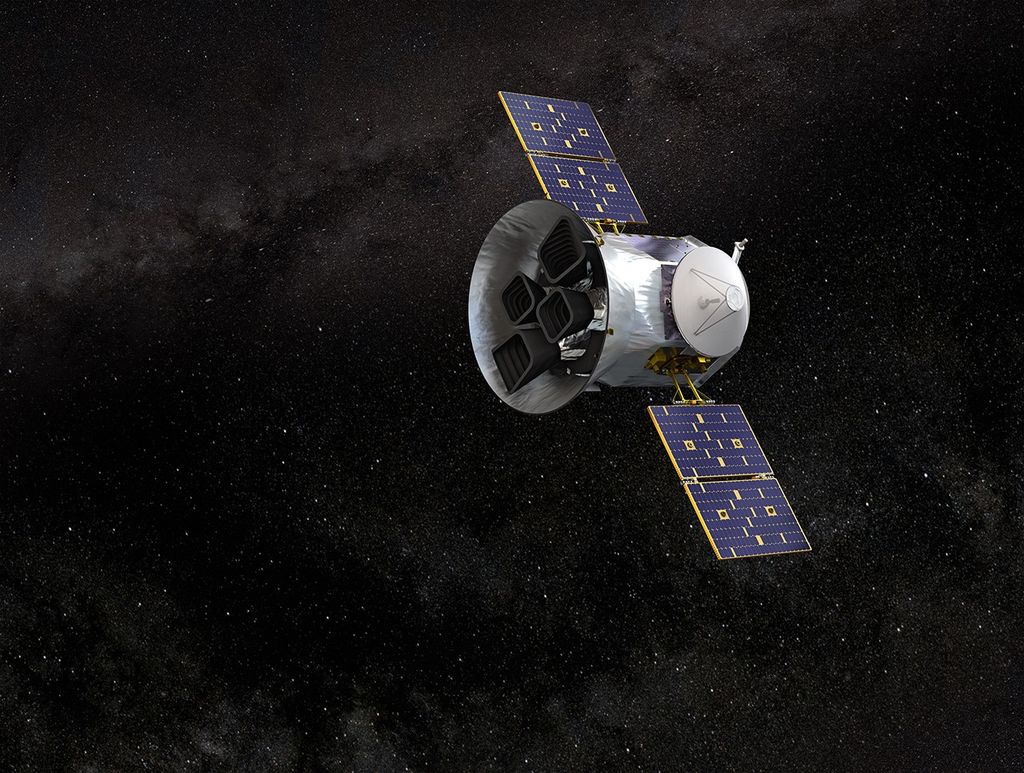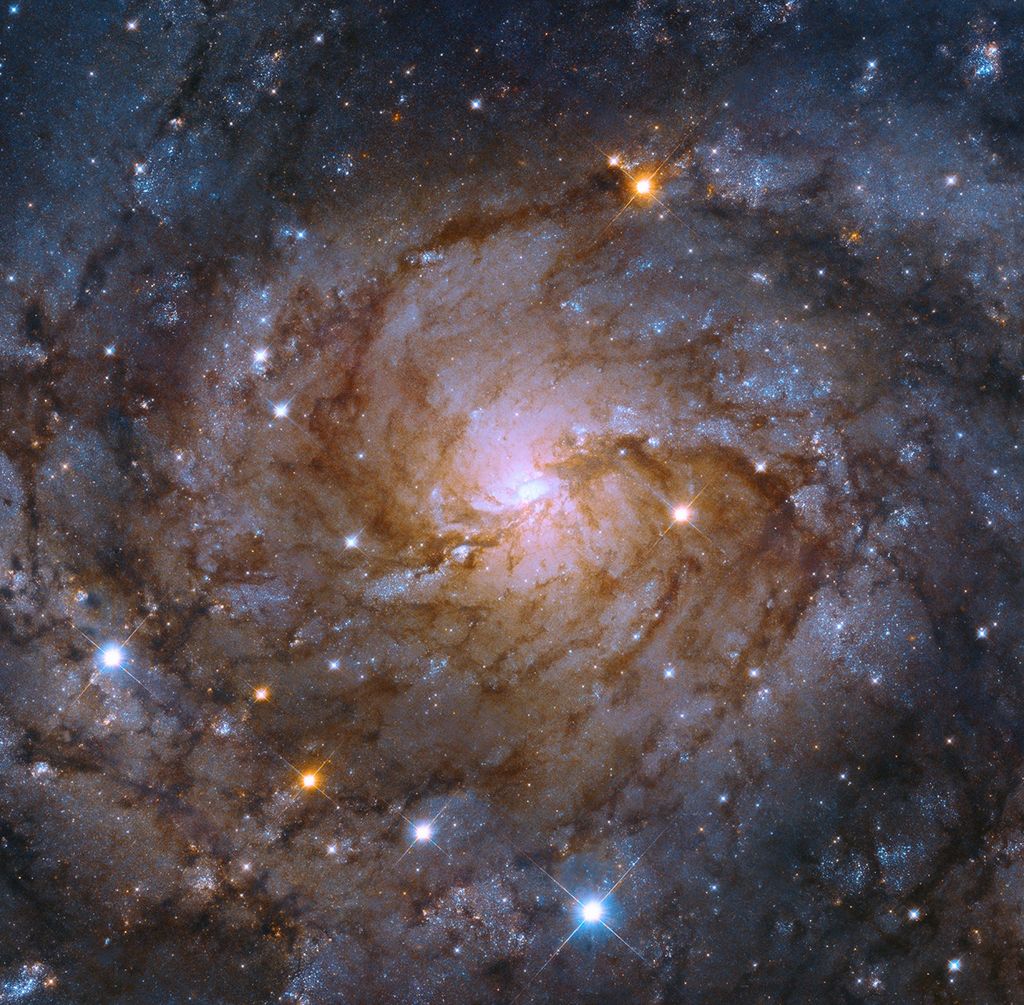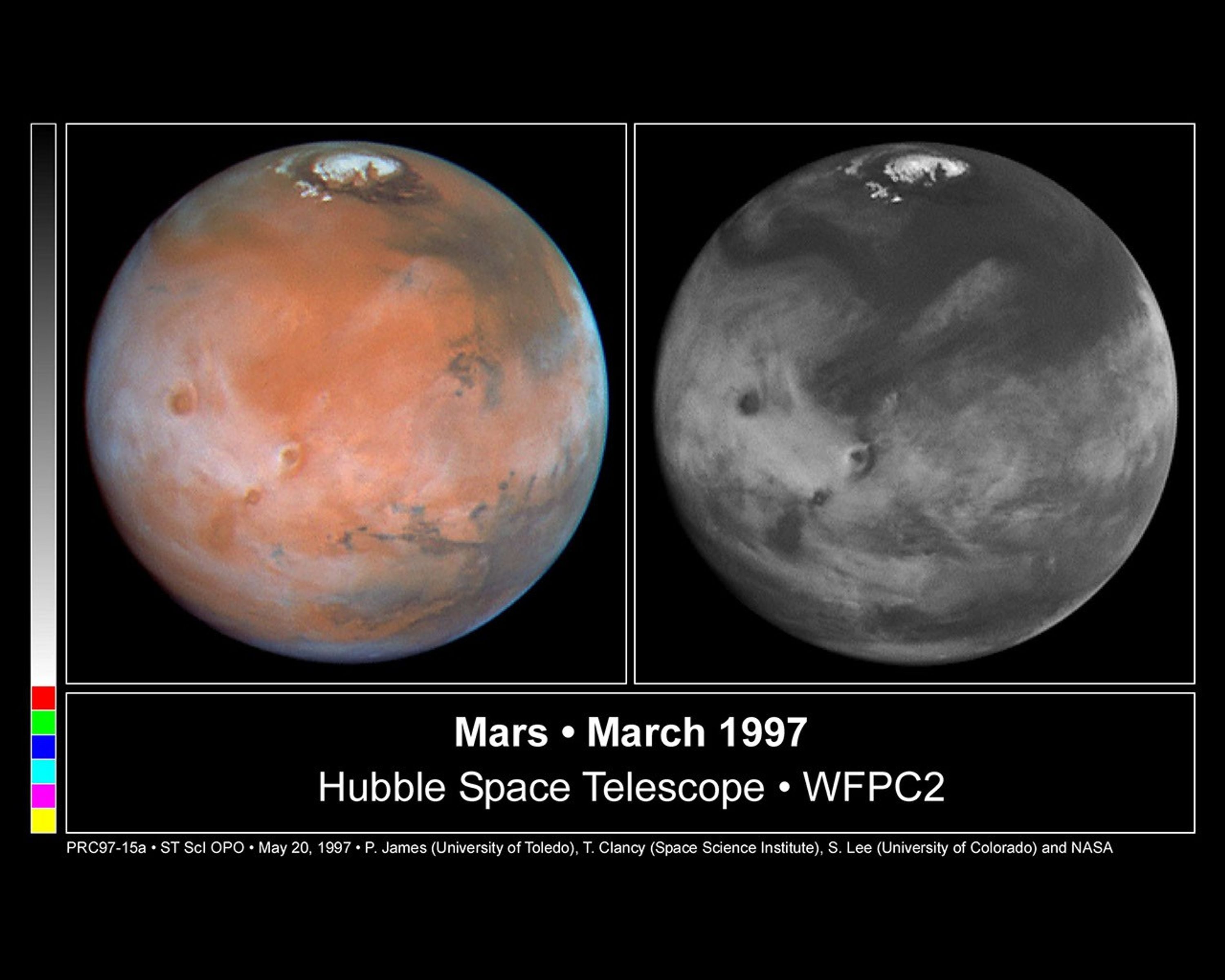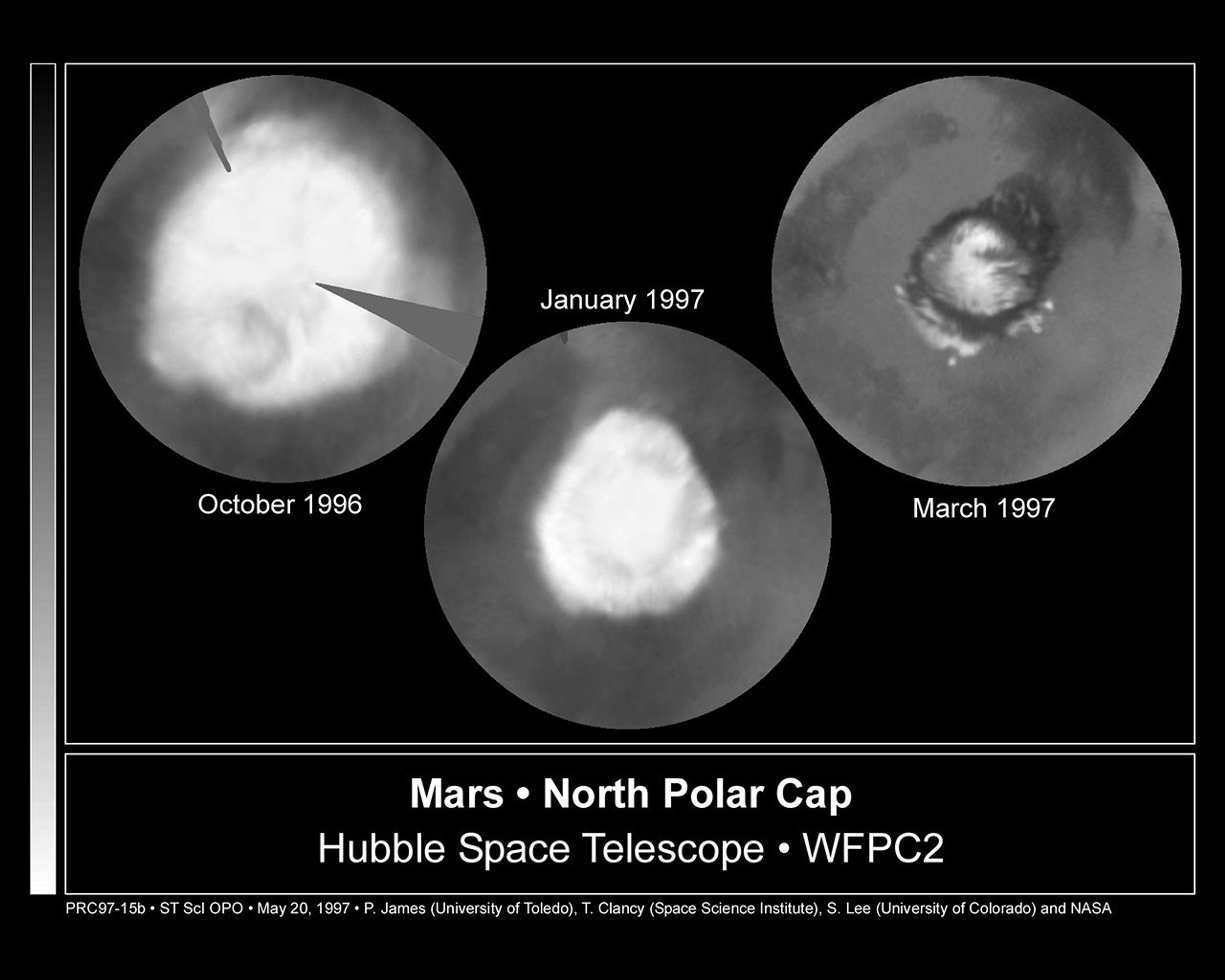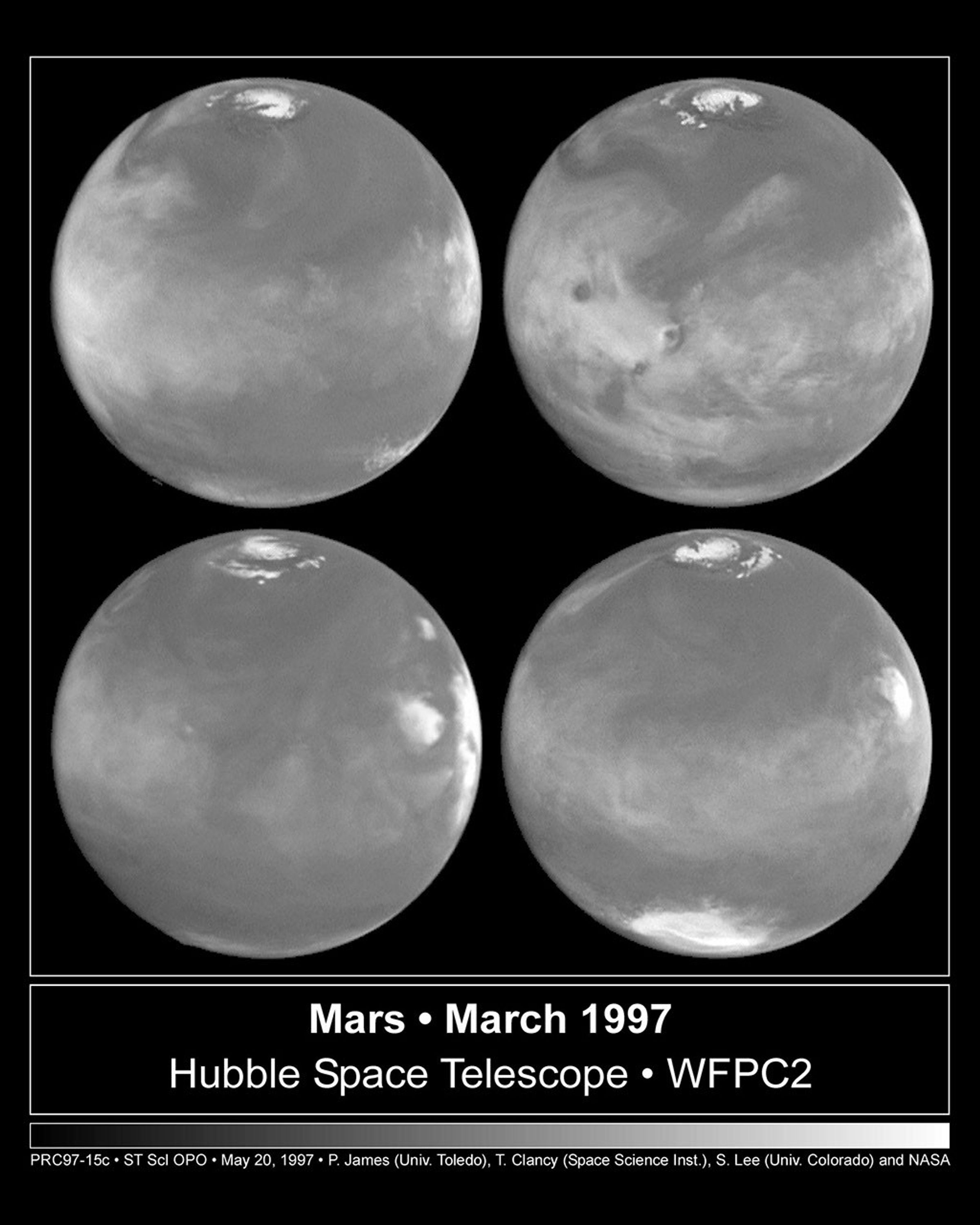As two NASA spacecraft speed toward a mid-year rendezvous with Mars, astronomers using the Hubble Space Telescope are providing updated planetary weather reports to help plan the missions.
Hubble's new images show that the "martian invasion" of spacecraft will experience considerably different weather conditions than seen by the last U.S. spacecraft to land on Mars 21 years ago.
Martian atmospheric conditions will affect the operation of both the Mars Pathfinder landing on July 4, and the September 11 arrival of the Mars Global Surveyor which will map the planet from orbit. Hubble images taken barely three weeks apart, on March 10 and March 30, reveal dramatic changes in some local conditions, and show overall cloudier and colder conditions than Viking encountered two decades ago.
"Because Pathfinder uses the atmosphere to decrease its velocity for landing, and because the lander and rover are solar-powered, understanding the state of the atmosphere prior to landing is important," said Dr. Matthew Golombek, Pathfinder project scientist at NASA's Jet Propulsion Laboratory, Pasadena, CA.
"On July 4, Mars Pathfinder will enter the atmosphere directly from approach and slow itself behind an aeroshell with a parachute, small solid rockets and giant airbags. The lander carries a small rover to explore the surface and investigate the kinds of materials present. Hubble images of Mars are helping us to adjust our flight path for landing and effectively plan surface operations," said Golombek.
"It's not the dusty Mars of the Project Viking days (mid 1970s to early 1980s) or the habitable oasis of science fiction stories," says Todd Clancy of the Space Science Institute in Boulder, CO. "We're finding a Mars that's colder, clearer, cloudier. Hubble is rapidly changing our view of Mars' environment. The planet's weather apparently has a flip-side to it."
Hubble's findings also offer new insights into the differences and similarities of weather on the other terrestrial planets. "The planets are similar in many important ways, so the very major differences between them are interesting from a viewpoint of understanding meteorology better," said team leader Phil James of the University of Toledo in Ohio. "Hubble is allowing us to look at Mars in ways never before seen."
In September, NASA's Mars Global Surveyor will skim across the upper martian atmosphere to slow down by friction and enter orbit around the red planet. Atmospheric density is a key factor in precisely executing this complex and delicate aerobraking maneuver. Hubble is ideal for tracking regional dust storms which could pose a threat to Surveyor by drastically changing the planet's air density. Such storms can cause a tenfold increase in the martian atmosphere's drag at 60 miles above the surface.
Comparing the appearance of Mars to that in earlier spacecraft observations, Hubble has found some areas of the martian surface that have been changed dramatically by wind-blown dust. The most prominent example is the "classic dark feature" called Cerberus, which is roughly the size of California (800 by 250 miles). This feature has been seen as a low albedo (dark) region by ground-based telescopic observers since early this century, and was studied in detail by the Mariner 9 and Viking orbiters in the 1970s.
In Hubble's view, only three dark splotches remain, probably related to dark sand being carried out of craters by the wind. The astronomers think that dust storms in the region have covered the formerly dark surface with bright dust, effectively erasing Cerberus from the map.
Hubble is ideally suited for long-term study of Mars. When Mars has been closest to Earth, Hubble has resolved surface details as small as 25 miles across. This allows astronomers to track subtleties in the shifting cloud patterns and periodic dust storms. This planet-wide "weather satellite" view is complementary to the close-up views which will be provided by Mars Pathfinder and Mars Global Surveyor.
BACKGROUND INFORMATION: MARS' CHAOTIC CLIMATE
If you think the weather on Earth is unpredictable, try living on Mars. One week, the sky is pink and cloudless, filled with windblown dust raised from the rusty Martian surface. By Martian standards, it's warm, about minus 40 degrees Fahrenheit. Then, in a matter of days, the dust is swept from the atmosphere, temperatures plummet 40 degrees, and brilliant water ice clouds appear against a dark blue sky.
Dramatic weather changes like these may not seem very different from a batch of severe thunderstorms passing through your home town, but for Mars these changes can sweep over the entire planet every week. It appears that Mars' roller coaster-like weather is more chaotic and unpredictable than scientists first thought. Observations by the Hubble Space Telescope and the National Radio Astronomy Observatory (NRAO) radio telescope at Kitt Peak, Ariz., show that the atmosphere of Mars is more complex and variable than the picture revealed by the Viking and Mariner 9 orbiters. These spacecraft collected information from the planet in the 1970's and painted a fairly one-dimensional picture of Mars' climate. Images snapped by the orbiters revealed huge dust storms spreading throughout the entire atmosphere when Mars was closest to the sun (perihelion). These dusty conditions continued to dominate the planet's climate when it was farthest from the sun (aphelion). (Perihelion and aphelion occur every Mars year, which equals two Earth years. Aphelion occurs in northern summer, perihelion in southern summer.)
But information captured by Hubble and NRAO show that Mars is more often cloudy than dusty, experiencing abrupt planet-wide swings between dusty and hot and cloudy and cold. A state of emergency would be declared on Earth if an ice or dust storm blanketed the entire planet.
These shifts in climate are driven by three important factors: Mars' thin atmosphere, its elliptical orbit around the sun, and strong climatic interactions between dust and water ice clouds in the atmosphere. Mars' atmosphere is so thin that it weighs less than 1 percent of Earth's atmosphere. Because Mars' atmosphere is so paper-thin and there are no oceans to store up heat from the sun, the planet's temperatures respond more quickly and intensely to surface changes and atmospheric heating by the sun. There are also much larger annual changes in sunlight falling on Mars than on Earth, because Mars' distance from the sun varies by 20 percent in its orbit around the sun every two years.
Mars' elliptical orbit leads to planet-wide changes in atmospheric and surface temperatures over the course of a Mars year. During perihelion, when Mars is closest to the sun (summer in the southern hemisphere), the planet receives 40 percent more sunlight than during aphelion, when it is farthest from the sun (summer in the northern hemisphere). This annual variation in sunlight causes 35-degree Fahrenheit increases during southern summer (perihelion), forcing continental-scale dust storms at the planet's surface. The dust is swept aloft to altitudes of tens of miles, where it spreads globally, absorbs light from the sun, and heats the entire atmosphere by another 30 to 50 degrees Fahrenheit. This dusty perihelion climate was observed by Viking and Mariner 9 and by NRAO in 1992, 1994, and 1996.
But what the 1970's orbiters did not identify was the very distinctive Mars aphelion climate, with its planet-wide belts of water ice clouds. These clouds are as striking as the perihelion global dust storms. During the aphelion climate, surface dust raised by low dust storms is confined to low altitudes (about 10 km or 6 miles), and is eventually swept to the ground by water ice clouds. These clouds surround the planet at altitudes of 3 to 10 km (2 to 6 miles). It is the cold atmospheric conditions of Mars during aphelion, when the sun is much weaker, that stimulate the formation of these water ice clouds. The clouds further reduce atmospheric temperatures by forming around the dust. Without sunlight, the dust freezes and falls to the ground. This strong competition between dust heating and cloud cooling drives sweeping annual and short-term regional changes in Mars' climate.


















